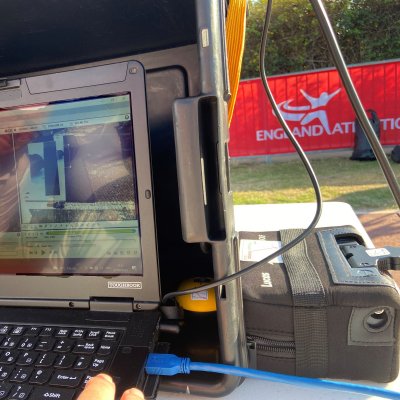Get ready for the outdoor season!
Across England, as a result of the World Athletics rules being updated, including the take-off rule in Long Jump and Triple Jump, a number of UKA officials have been developing and testing a number of simplified video review systems with some notable success.
Rule TR30.1 states: ‘An Athlete fails if they while they while taking off (prior to the instant at which they cease contact with the take-off board or ground), break the vertical plane of the take-off line with any part of their take-off foot/shoe, whether running up without jumping or in the act of jumping’. In summary, this means that an athlete cannot ‘break’ the vertical plane of the take-off line regardless of whether there is a plasticine board or not.

While video equipment on the take-off board may be available to assist judges at UKA televised meetings or some tri-regional championship events in England, often this technology is not available/feasible for events below this level. For meetings that do not or are unable to have this technology available, it is recommended that a 90-degree plasticine insert can still be the norm or a flat board in a contrasting colour is in place. An athlete might not make a mark on the 90-degree plasticine board but breaks the vertical plane of the take-off line. This is still recorded as a no jump.
In the last twelve months, a number of UKA officials have been developing and testing a number of simpler video review systems. We were able to use and test some of these systems during the indoor season at the England Athletics Championships.
This means that the normal plasticine-edged no-jump indicator can be replaced by a flat board, in a contrasting colour. Discussions with coaches and athletes have indicated that they would prefer this to be the same wooden surface as the take-off board, though the contrasting colour may be achieved by covering it with a layer of coloured tape. Even without a video system in use, there is no necessity now to use the plasticine (which was used to give evidence to the athlete); it becomes the same as the throws in that the athlete has to trust the decision of the judge.
Depending on where the video camera technology is located, some officiating positions may differ and it is accepted that at the moment, athletes and officials may experience different set ups at different events.

In summary:
Facilities can provide
- a 90 degree plasticine no jump indicator.
- or a flat board, in a contrasting colour in place of the no jump indicator board.
- and/or a simple video camera and display screen set up at the take off board.
Officiating duties may be
- the usual process where an official watches for a no jump and raises a red or white flag as appropriate.
- as above but with an extra official operating the video system close by who can indicate to the official with the flags.
- the official watching the board is positioned so that they can see the take off both directly and via the video screen, and opeates the flags (or coloured lights) themselves.
If any competition organiser or facility needs further advice, please contact our Officials' Development Officer Marc Ritchie.
